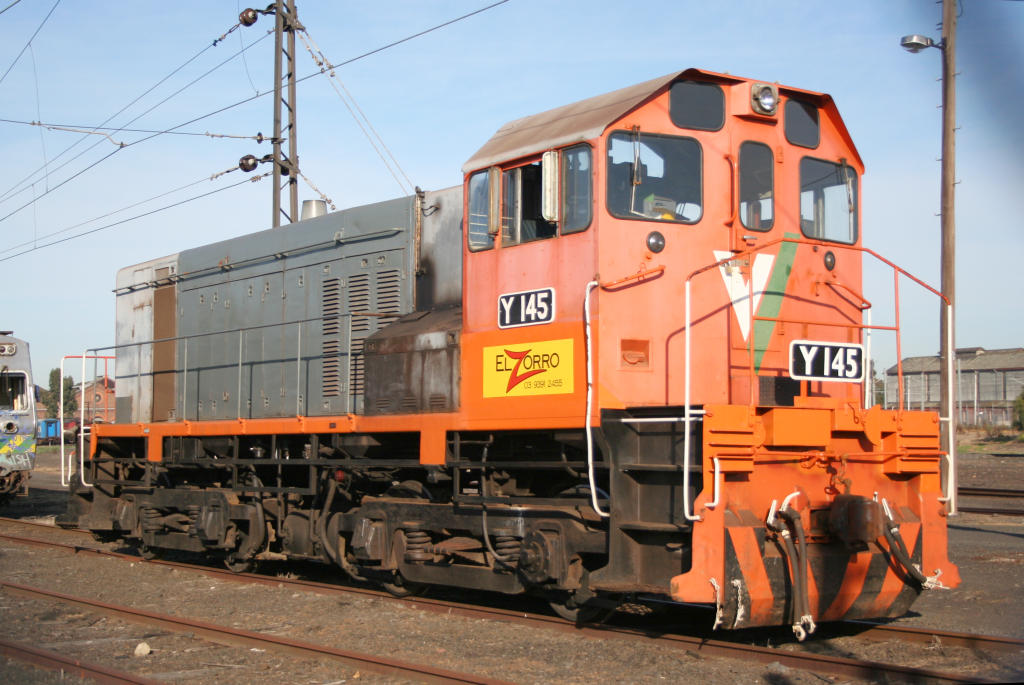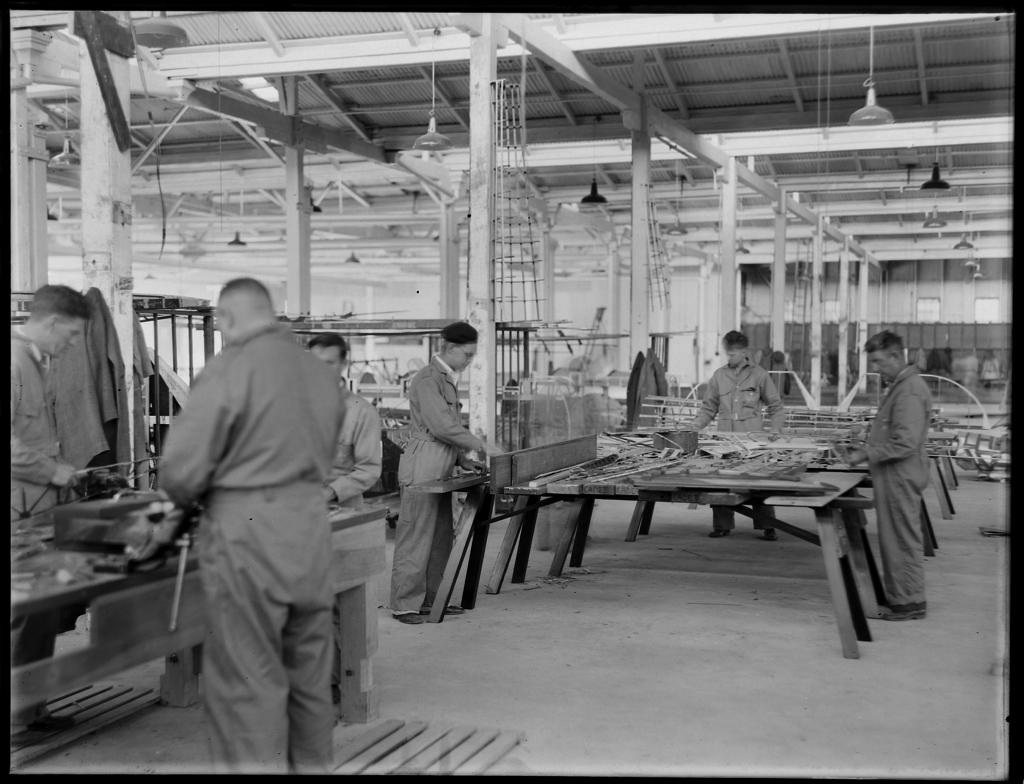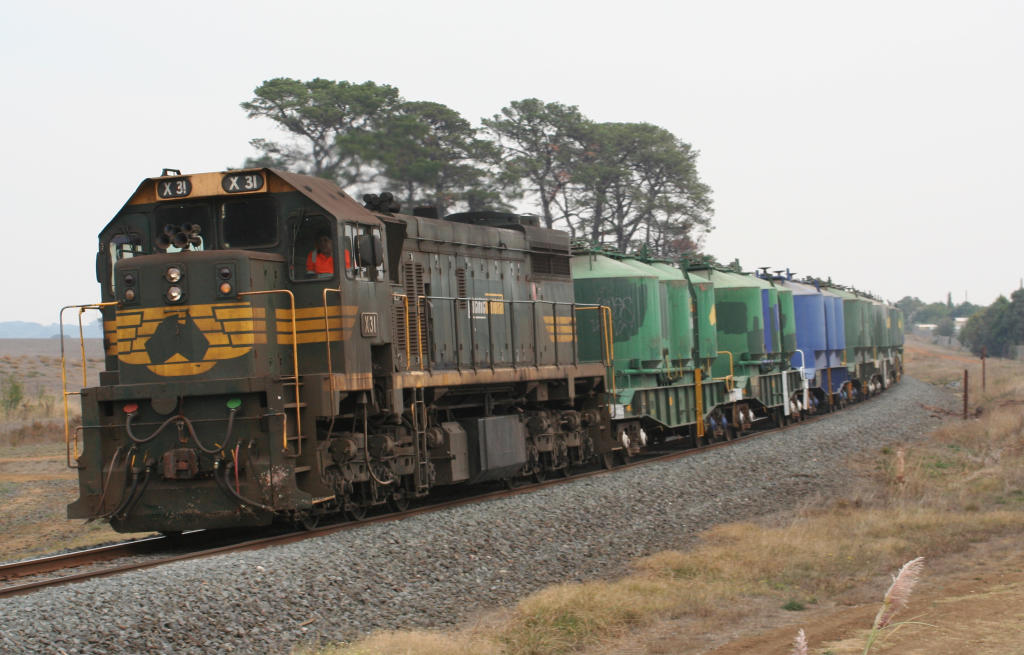|
Victorian Railways Y Class (diesel)
The Y class are a class of diesel locomotives built by Clyde Engineering, Granville for the Victorian Railways between 1963 and 1968. History In 1963, the first of 25 general purpose diesel-electric locomotives was delivered by Clyde Engineering. As a cost saving measure, they were built with bogies and motors retrieved from scrapped Swing Door electric suburban train sets; the re-use of these components reduced the unit cost of the Y class locomotive from around £52,000 ( $104,000) to £40,000 ($80,000). Two further orders saw the class total 75 by 1968. Although built to dieselise Victoria's shunting operations and replace steam locomotives on branch line services, they were also used on mainline goods and passenger services, including between Spencer Street and Werribee. After closure of branch lines across the state and the end of short pick-up goods trains, use of the class dropped. In the 1980s, it is thought that four Y Class locomotives were on standard gauge, t ... [...More Info...] [...Related Items...] OR: [Wikipedia] [Google] [Baidu] |
Clyde Engineering
Clyde Engineering was an Australian manufacturer of locomotives, rolling stock, and other industrial products. It was founded in September 1898 by a syndicate of Sydney businessmen buying the Granville factory of timber merchants Hudson Brothers. The company won contracts for railway rolling stock, a sewerage system, trams and agricultural machinery. In 1907 it won its first contract for steam locomotives for the New South Wales Government Railways. By 1923 it had 2,200 employees. After contracting during the depression it became a major supplier of munitions during World War II. In 1950 it was awarded the first of many contracts for diesel locomotives by the Commonwealth Railways after it was appointed the Australian licensee for Electro-Motive Diesel products. Apart from building locomotives and rolling stock, Clyde Engineering diversified into telephone and industrial electronic equipment, machine tools, domestic aluminium ware, road making and earth making equipmen ... [...More Info...] [...Related Items...] OR: [Wikipedia] [Google] [Baidu] |
Y129 VLine
Y1 has several uses including: * Boeing Y1, the anticipated replacement for the company's existing Boeing 737 airliner * Great Northern Y-1, an electric locomotive used by the Great Northern Railway. * Y1 adrenocortical cell, a mouse cell line * Y1 (railcar), a Swedish-made diesel multiple unit train * Y1 (tobacco), a genetically altered tobacco and also : * Blue Air Blue Air is a Romanian low-cost airline headquartered in Bucharest, with its hub at Henri Coandă International Airport. It is the largest Romanian airline by scheduled passengers flown. In 2017, Blue Air carried over 5 million passengers, a 40% ... IATA airline code * y1, Yellow seed 1, a sorghum gene implied in the phlobaphene pigments pathway {{Letter-NumberCombDisambig ... [...More Info...] [...Related Items...] OR: [Wikipedia] [Google] [Baidu] |
Pacific National Diesel Locomotives
The Pacific Ocean is the largest and deepest of Earth's five oceanic divisions. It extends from the Arctic Ocean in the north to the Southern Ocean (or, depending on definition, to Antarctica) in the south, and is bounded by the continents of Asia and Oceania in the west and the Americas in the east. At in area (as defined with a southern Antarctic border), this largest division of the World Ocean—and, in turn, the hydrosphere—covers about 46% of Earth's water surface and about 32% of its total surface area, larger than Earth's entire land area combined .Pacific Ocean . '' Britannica Concise.'' 2008: Encyclopædia Britannica, Inc. The centers of both the |
Clyde Engineering Locomotives
Clyde may refer to: People * Clyde (given name) * Clyde (surname) Places For townships see also Clyde Township Australia * Clyde, New South Wales * Clyde, Victoria * Clyde River, New South Wales Canada * Clyde, Alberta * Clyde, Ontario, a town in North Dumfries, Regional Municipality of Waterloo, Ontario * Clyde Township, a geographic township in the municipality of Dysart et al, Ontario * Clyde River, Nunavut New Zealand * Clyde, New Zealand ** Clyde Dam Scotland * Clydeside * River Clyde * Firth of Clyde United States * Clyde, California, a CDP in Contra Costa County * Clyde, Georgia * Clyde Township, Whiteside County, Illinois * Clyde, Iowa * Clyde, Kansas * Clyde, Michigan * Clyde Township, Allegan County, Michigan * Clyde Township, St. Clair County, Michigan * Clyde, New Jersey * Clyde, New York * Clyde, North Carolina * Clyde, North Dakota * Clyde, Ohio ** Clyde cancer cluster * Clyde, Pennsylvania * Clyde, South Carolina * Clyde, Texas * Clyde River (Vermont) The ... [...More Info...] [...Related Items...] OR: [Wikipedia] [Google] [Baidu] |
Bo-Bo Locomotives
B-B and Bo-Bo are the Association of American Railroads (AAR) and British classifications of wheel arrangement for railway locomotives with four axles in two individual bogies. They are equivalent to the B′B′ and Bo′Bo′ classifications in the UIC system. The arrangement of two, two-axled, bogies is a common wheel arrangement for modern electric and diesel locomotives. Bo-Bo Bo-Bo is the UIC indication of a wheel arrangement for railway vehicles with four axles in two individual bogies, all driven by their own traction motors. It is a common wheel arrangement for modern electric and diesel-electric locomotives, as well as power cars in electric multiple units. Most early electric locomotives shared commonalities with the steam engines of their time. These features included side rods and frame mounted driving axles with leading and trailing axles. The long rigid wheelbase and the leading and trailing axles reduced cornering stability and increased weight. The Bo-Bo c ... [...More Info...] [...Related Items...] OR: [Wikipedia] [Google] [Baidu] |
Newport Railway Museum
The Newport Railway Museum is located on Champion Road, Newport, Victoria, near the North Williamstown station. History The museum opened on 10 November 1962, after the Australian Railway Historical Society (ARHS) Victorian Division was allocated space at Newport Workshops by the Victorian Railways to develop a collection of key examples of steam locomotives that were then in the process of being replaced by diesel and electric locomotives. By the late 1980s, the early diesel and electric locomotives that had replaced steam traction were themselves nearing end of life, and the museum expanded its collection to incorporate a number of key examples. Following a safety audit by VicTrack, the landlord and owner of most of the exhibits, the museum closed in February 2010. After various improvements, it reopened in March 2014. On 16 June 2020, it was announced that the ARHS had withdrawn from the operation of the museum and a new group, Newport Railway Museum Inc., formed by museum v ... [...More Info...] [...Related Items...] OR: [Wikipedia] [Google] [Baidu] |
Victorian Goldfields Railway
The Victorian Goldfields Railway is a broad gauge tourist railway in Victoria, Australia. It operates along a formerly disused branch line between the towns of Maldon and Castlemaine. History The original line was opened on 16 June 1884, opening up rail access from the established station at Castlemaine to the towns of Muckleford and Maldon. The area was prosperous, as Castlemaine and Maldon had both experienced gold rushes in the preceding years, and local residents had been petitioning the government for a railway since 1874. On 2 August 1884, a contract was let for an extension to Laanecoorie, however further construction was suspended after the line reached the small town of Shelbourne in 1891. The line was served by twice-daily trains for the first forty years of its life, which was increased to four-times-daily trains in 1924. However, these were cut back at the end of the 1920s due to a decrease in the local population, and passenger services were eliminated altogeth ... [...More Info...] [...Related Items...] OR: [Wikipedia] [Google] [Baidu] |
Victorian Railways X Class (diesel)
The X class are a class of mainline diesel locomotives built by Clyde Engineering, Granville and Rosewater for the Victorian Railways between 1966 and 1976. History In preparation for the opening of the standard gauge line between Melbourne and Albury, the Victorian Railways had purchased a further eight S class locomotives, with the last of these entering service in 1961. But from that date traffic had increased, with a 20% increase in train miles being run by the end of the financial year by the middle of 1965, so the fleet was being stretched beyond reasonable capabilities.Newsrail June 2015 (Vol. 43, Issue 6)pp167-175 Standard gauge trains at the time were typically rostered for a single S class locomotive, which could deliver approximately 1,800 hp. When one wasn't available, two T class locomotives (each delivering approximately 950 hp) could be and were used in lieu. This strategy could not, however, be a long-term solution as the T class had been designed ... [...More Info...] [...Related Items...] OR: [Wikipedia] [Google] [Baidu] |
V/Line A Class
The A class are a class of diesel locomotives rebuilt from Victorian Railways B class locomotives by Clyde Engineering, Rosewater in South Australia for V/Line in 1984–1985. History The class were rebuilt from B class locomotives originally constructed in the 1950s, as part of the ''New Deal'' reforms of passenger rail operations in Victoria. The rebuild contract was let in January 1983 to Clyde Engineering, Rosewater with the first locomotive entering service in May 1984, but the project was abandoned in mid 1985 after rising costs due to structural fatigue, with the 11th rebuild delivered in August 1985. It was decided to instead built more of the N class locomotives, mechanically similar to the A class. The major difference was the addition of head end power generators, as it was believed this was a more efficient way of supplying power for air-conditioning and lighting than power vans or individual generator sets under carriages. Four locomotives were named after Aust ... [...More Info...] [...Related Items...] OR: [Wikipedia] [Google] [Baidu] |
Werribee Railway Station
Werribee railway station is the terminus of the electrified suburban Werribee line in Victoria, Australia. It serves the western Melbourne suburb of Werribee, and it opened on 25 June 1857.Werribee Vicsig The , which runs between Melbourne and , passes to the north of Platform 1. History Werribee station was opened by theGeelong and Melbourne Railw ...
[...More Info...] [...Related Items...] OR: [Wikipedia] [Google] [Baidu] |
Southern Cross Railway Station
Southern Cross railway station (until 2005 known as Spencer Street station) is a major railway station in Docklands, Victoria, Docklands, Melbourne. It is on Spencer Street, Melbourne, Spencer Street, between Collins Street, Melbourne, Collins and La Trobe Street, Melbourne, La Trobe Streets, at the western edge of the Melbourne city centre, Melbourne central business district. The Docklands Stadium sports arena is 500 metres north-west of the station. The station is owned, operated and maintained by Civic Nexus, a subsidiary of IFM Investors and operating as Southern Cross Station Pty Ltd, under a 30-year lease to 2036 from the Victorian State Government, as part of a public-private partnership. Southern Cross Station Pty Ltd contracts Infranexus Management Pty Ltd (Infranexus) for management services. Infranexus is also wholly owned by IFM. The station is the terminus of the List of regional railway stations in Victoria, state's regional railway network operated by V/Line, ' ... [...More Info...] [...Related Items...] OR: [Wikipedia] [Google] [Baidu] |
Australian Dollar
The Australian dollar (sign: $; code: AUD) is the currency of Australia, including its external territories: Christmas Island, Cocos (Keeling) Islands, and Norfolk Island. It is officially used as currency by three independent Pacific Island states: Kiribati, Nauru, and Tuvalu. It is legal tender in Australia.''Reserve Bank Act 1959'', s.36(1) an ''Currency Act 1965'', s.16 Within Australia, it is almost always abbreviated with the ($), with A$ or AU$ sometimes used to distinguish it from other |


.jpg)





